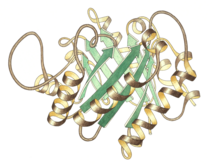
Back مصاوغة التريوز فسفات Arabic Trioza-fosfat izomeraza BS Triosa fosfat isomerasa Catalan Triosephosphatisomerase German Triosa fosfato isomerasa Spanish تریوز فسفات ایزومراز Persian Trioosifosfaatti-isomeraasi Finnish Triose-phosphate isomérase French Triosa-fosfato isomerase Galician טריוז פוספט איזומראז HE
| triosephosphate isomerase | |||||||||
|---|---|---|---|---|---|---|---|---|---|
 Side view of triose P isomerase monomer, active site at top center | |||||||||
| Identifiers | |||||||||
| EC no. | 5.3.1.1 | ||||||||
| CAS no. | 9023-78-3 | ||||||||
| Databases | |||||||||
| IntEnz | IntEnz view | ||||||||
| BRENDA | BRENDA entry | ||||||||
| ExPASy | NiceZyme view | ||||||||
| KEGG | KEGG entry | ||||||||
| MetaCyc | metabolic pathway | ||||||||
| PRIAM | profile | ||||||||
| PDB structures | RCSB PDB PDBe PDBsum | ||||||||
| Gene Ontology | AmiGO / QuickGO | ||||||||
| |||||||||
Triose-phosphate isomerase (TPI or TIM) is an enzyme (EC 5.3.1.1) that catalyzes the reversible interconversion of the triose phosphate isomers dihydroxyacetone phosphate and D-glyceraldehyde 3-phosphate.
| Dihydroxyacetone phosphate | triose phosphate isomerase | D-glyceraldehyde 3-phosphate | |

|

| ||

| |||
| triose phosphate isomerase | |||
Compound C00111 at KEGG Pathway Database.Enzyme 5.3.1.1 at KEGG Pathway Database.Compound C00118 at KEGG Pathway Database.
TPI plays an important role in glycolysis and is essential for efficient energy production. TPI has been found in nearly every organism searched for the enzyme, including animals such as mammals and insects as well as in fungi, plants, and bacteria. However, some bacteria that do not perform glycolysis, like ureaplasmas, lack TPI.
In humans, deficiencies in TPI are associated with a progressive, severe neurological disorder called triose phosphate isomerase deficiency. Triose phosphate isomerase deficiency is characterized by chronic hemolytic anemia. While there are various mutations that cause this disease, most include the replacement of glutamic acid at position 104 with an aspartic acid.[1]
Triose phosphate isomerase is a highly efficient enzyme, performing the reaction billions of times faster than it would occur naturally in solution. The reaction is so efficient that it is said to be catalytically perfect: It is limited only by the rate the substrate can diffuse into and out of the enzyme's active site.[2][3]
- ^ Orosz F, Oláh J, Ovádi J (December 2006). "Triosephosphate isomerase deficiency: facts and doubts". IUBMB Life. 58 (12): 703–15. doi:10.1080/15216540601115960. PMID 17424909.
- ^ Albery WJ, Knowles JR (December 1976). "Free-energy profile of the reaction catalyzed by triosephosphate isomerase". Biochemistry. 15 (25): 5627–31. doi:10.1021/bi00670a031. PMID 999838.
- ^ Rose IA, Fung WJ, Warms JV (May 1990). "Proton diffusion in the active site of triosephosphate isomerase". Biochemistry. 29 (18): 4312–7. doi:10.1021/bi00470a008. PMID 2161683.
© MMXXIII Rich X Search. We shall prevail. All rights reserved. Rich X Search